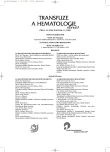-
Medical journals
- Career
LDL apheresis – evaluation of the results from 1000 performed procedures
Authors: M. Cermanová 1; M. Bláha 1; V. Bláha 2; E. Havel 3; P. Vyroubal 2; Z. Zadák 2; M. Blažek 1; J. Malý 1; V. Mašín 4
Authors‘ workplace: Oddělení klinické hematologie II. interní kliniky 1; Klinika gerontologická a metabolická 2; Chirugická klinika Fakultní nemocnice Hradec Králové a Lékařské Fakulty v Hradci Králové Univerzity Karlovy 3; Katedra lékařské biofyziky Lékařské Fakulty v Hradci Králové Univerzity Karlovy 4
Published in: Transfuze Hematol. dnes,11, 2005, No. 3, p. 116-121.
Category: Comprehensive Reports, Original Papers, Case Reports
Overview
The aim of this study was to evaluate 1000 LDL-apheresis procedures performed in 9 patients with severe familial lipid disorder. LDL-apheresis is a method of extracorporeal elimination of LDL-cholesterol, based on immunoadsorption and used in severe hyperlipidemia patients, refractory to conventional treatment.
Materials and methods:
Blood cells separators Cobe Spectra (COBE BCT, USA) were used to separate patient’s plasma. Immunoadsorption was performed by means of ADA or Adasorb (Medicap, Germany) and columns LDL-Lipopak (Pocard Ltd., Russia). Before and immediately after the procedure, blood samples were taken and serum levels of lipoproteins tested.Results:
the average period of treatment was 6.3 years, range 2.9 – 8.5. The number of aphereses performed per one patient was 111 ± 58. Average interval between two procedures was 18.9 ± 9.5 days. One procedure takes 3.8 ± 0.5 hours. Average volume of processed plasma was 6654 ± 968 ml, plasma volume per kilogram of body weight was 97 ± 26 ml/kg. Average plasma flow was 30 ± 4 ml/min, average blood flow 67.7 ± 5.4. The ACD-A: blood ratio 1 : 22 was used. The average flow of ACD-A was 3.1 ± 0.25 ml/min. Average ACD-A consumption per one apheresis procedure was 697 ± 118 ml. The average total cholesterol decrease was 70 ± 7%, LDL-cholesterol 84 ± 8%, HDL-cholesterol 26 ± 7% and triacylglycerides 56 ± 19% during one procedure. On the average 53.6 aphereses were performed per one pair of columns, range 11–109. One pair of columns was used on average 35.9 month. The adverse events were mostly mild and represented by vaso-vagal events and manifestations of citrate related toxicity.Conclusion:
Our modification of immunoadsorption is effective, selective and safe.Key words:
LDL-apheresis, familial hypercholesterolemia, immunoadsorption, effectivity, side-effects
Labels
Haematology Internal medicine Clinical oncology
Article was published inTransfusion and Haematology Today

2005 Issue 3-
All articles in this issue
- Hereditary hemochromatosis
- Benefit of the different sensitivity of aPTT reagent for diagnosis of lupus anticoagulant inhibitor
- Catalytic subunit of telomerase as a tumor antigen in multiple myeloma immunotherapy
- Detection of minimal residual disease in acute lymphoblastic leukemia using quantification of immunoglobulin and T-cell receptor genes rearrangements. How to avoid misinterpretation of the results
- LDL apheresis – evaluation of the results from 1000 performed procedures
- Blood donors satisfaction survey – public injury
- Transfusion and Haematology Today
- Journal archive
- Current issue
- Online only
- About the journal
Most read in this issue- Hereditary hemochromatosis
- Benefit of the different sensitivity of aPTT reagent for diagnosis of lupus anticoagulant inhibitor
- LDL apheresis – evaluation of the results from 1000 performed procedures
- Detection of minimal residual disease in acute lymphoblastic leukemia using quantification of immunoglobulin and T-cell receptor genes rearrangements. How to avoid misinterpretation of the results
Login#ADS_BOTTOM_SCRIPTS#Forgotten passwordEnter the email address that you registered with. We will send you instructions on how to set a new password.
- Career

